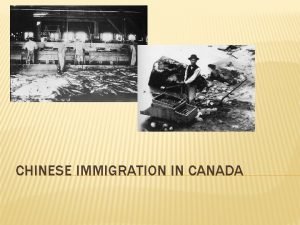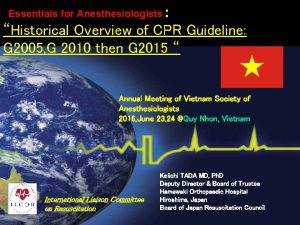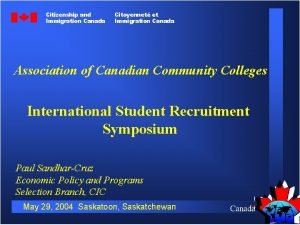CHINESE IMMIGRATION IN CANADA PUSH FACTORS There was








- Slides: 8

CHINESE IMMIGRATION IN CANADA

PUSH FACTORS There was a large population increase which lead to shortages of food. The shortages of food lead to not enough farmland jobs. There were also many rebellions which made it difficult for the government to sustain law and order. This created wandering gangs which raided Chinese villages. The Chinese people were fleeing this to try and find better living conditions, jobs and protection.

PULL FACTORS Canada was thought by the Chinese to be a golden land of opportunity where the Chinese could become wealthy and then return to their families in China. The earlier Chinese settlers came for the gold rush. Later, many more came to work on the building of the Canadian Pacific Railway. The Chinese men couldn't bring their families along with them to Canada, but they believed that they would be able to return to them as soon as the work was done. Many Chinese immigrants didn't make enough money to return home. They stayed in Canada to work in the plentiful resourcebased industries, such as fish, lumber and mining, that were a pull factor in deciding to come to Canada.

IMMIGRATION POLICIES Head tax or Chinese Immigration Act � � � Passed in 1885 by the federal government to limit the number of Chinese immigrants Every Chinese citizen had to pay a $50 head tax to get into Canada No other group had to pay a head tax Prevented a man's family from joining him in Canada In 1903 the tax increased to $500 person 1906 Immigration Act � All immigrants had to come to Canada via a direct route

SOCIAL STATUS Upon arrival to Canada the Chinese were immediately treated differently because of differences in appearance, language and customs. Among other BC citizens, the railroad officials that many Chinese were employed by treated them very harshly by paying them less to do more dangerous work than white men. Even with the decreased amount of pay that they received, the Chinese had to use their wages to buy supplies for their work and to pay for rooms and meals. White railroad workers did not have to pay for these expenses, and received twice the amount of pay for a day's work. Because of the crowded conditions in their home country, the Chinese were often looked upon as dirty by their white neighbors and couldn't be buried in the same cemeteries as them. In all, the Chinese immigrants occupied a very low rung on the social ladder and the Canadians did not want them in their country.

CONTRIBUTIONS One of the Chinese’s biggest contributions was the building of the CPR. After the Canadian Pacific Railway was completed, many Chinese couldn't afford to return to their families in China. Instead, they took on a large variety of jobs that contributed to Canada's economy and development. Chinese immigrants often took up occupations that didn't require extensive knowledge of English or any special training. Many chose to work in fish canneries, or as gardeners, servants or cooks in the homes of wealthy Canadian citizens. Others went to the East, to work in Albertan mines, or even further to open up cafés, hotels and laundries in densely populated areas.

DAILY LIFE � Work on the railroads � Ate rice and dried salmon and drank tea � Lived in tents or boxcars � Cooked over fires � Wore basic clothing to suit needs � Formed groups that became Chinatowns � Did most dangerous work on railroads � Had to buy all of their work supplies � Men had to leave their families in China

BIBLIOGRAPHY � � "Contributions of Early Chinese People. " School District 68. schools. sd 68. bc. ca/ladi/staff/grey/canada/chincontrib. htm (accessed April 26, 2012). Cranny, Michael William. Horizons: Canada moves West. Scarborough, Ont. : Prentice Hall Ginn Canada, 1999. Cruxton, J. Bradley, and W. Douglas Wilson. Flashback Canada. 3 rd ed. Toronto: Oxford University Press, 1994. "History - Chinese - Explore the Communities - The Kids' Site of Canadian Settlement - Library and Archives Canada. " http: //www. collectionscanada. gc. ca/premierescommunautes/jeunesse/0210132031. 1 -e. html (accessed April 27, 2012). Pictures � � Chinese workers cleaning fish, circa 1868 -1923 Source: Library and Archives Canada/William James Topley collection/PA 011605 © Public Domain. . Credit: William James Topley. nlc-8645 Chinese man washing gold, Fraser River, circa 1875 Source: Library and Archives Canada/Ken and Jenny Jacobson collection/PA 125990 © Public Domain nlc-8643















